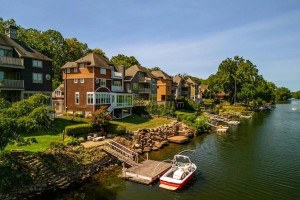The Journey to 1001 at Broad and Washington Is Finished (Sort Of)
Since One Thousand One first surfaced a decade (!) ago, the rental market has changed considerably. Here’s how this project has adapted.
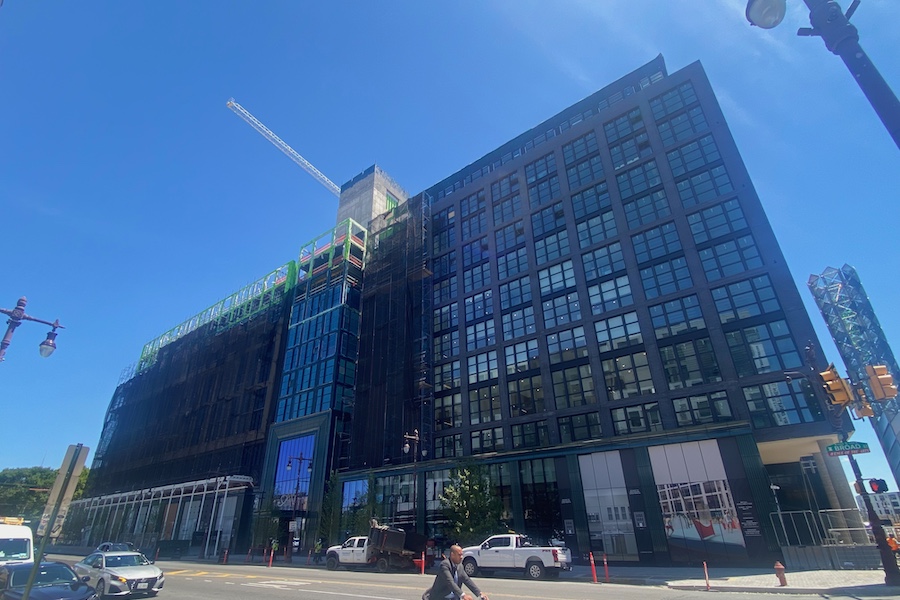
One Thousand One (1001 South Broad Street) looked like this the day before Independence Day. It still has a little ways to go before it’s topped off and even further before it’s finished. But Post Brothers is already welcoming potential and actual tenants. / This and all photographs marked with asterisks: Sandy Smith; all others courtesy Post Brothers. Renderings: BKV Architects via Post Brothers
The upper stories of One Thousand One haven’t even been finished yet, but the first tenants have already moved in — the building officially opened for occupancy on July 1.
And the building at the northeast corner of Broad Street and Washington Avenue — the first phase of a three-phase apartment development spanning a block and a half at the Hawthorne neighborhood’s southwest corner — offers a glimpse into the future of apartment living.
This much became clear when I toured the not-yet-finished One Thousand One in early July with Mike Pestronk, CEO of Post Brothers, the company that went in with Bart Blatstein’s Tower Investments to make this project a reality.
Post Brothers specializes in building luxurious, amenity-rich rental buildings that appeal to both younger tenants and those young at heart. The company proved to be a good partner for Blatstein, who first proposed building a 30-story, 800-unit apartment tower atop retail shops at this corner a decade ago.
That project went through several permutations — the original tower became two, then one again, then got L-shaped — but every permutation Blatstein presented got blowback from Hawthorne neighbors and ran into headwinds at the Zoning Board of Adjustment. (You can read our nearly blow-by-blow coverage of the saga of 1001 South Broad here.)
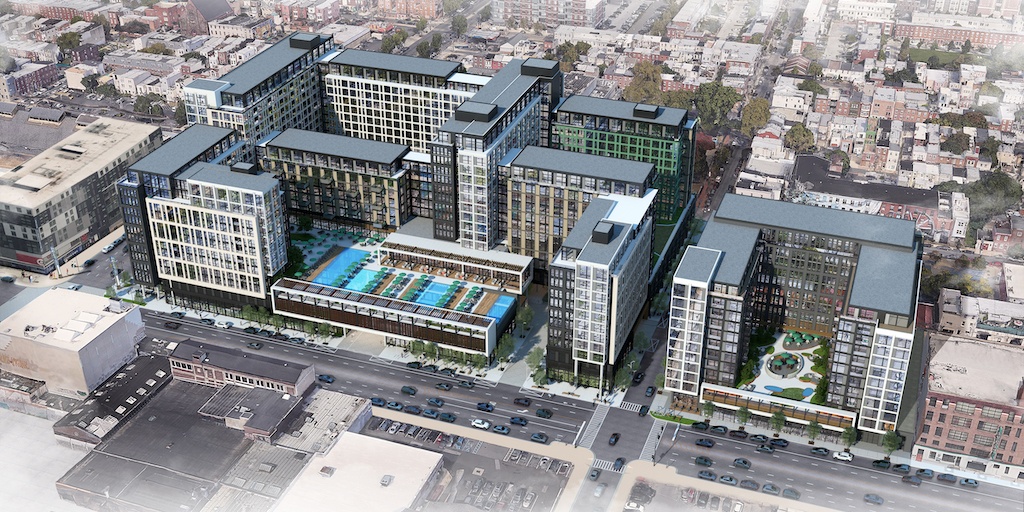
Rendering of the finished project. The first phase, One Thousand One (left), is now nearing completion. Post Brothers aims to complete everything by 2026.
Then Post Brothers took a 50 percent stake in the project, including overseeing its construction. In came a new architect — one that Post Brothers had used on its previous from-the-ground-up project, the Piazza Terminal in Northern Liberties, built on a site Post Brothers purchased from Blatstein — and a radically different design.
One Thousand One, the E-shaped building in the rendering above, is the first result of that makeover. And it shows how apartment developers are responding to times that were changing rapidly as this building was rising.
Post Brothers was an early responder to those changes: Its kid-friendly Poplar building in West Poplar has proven to be a harbinger of things to come. And One Thousand One is even more kid- and family-friendly.
One reason why: Pestronk says that, in this market at least, the families who move into One Thousand One will be sticking around longer because even the more affluent families this building appeals to have a harder time finding living space they can afford.
Over the past two decades, he says, households have continued to form, but home construction hasn’t kept pace with household growth. “The demand for housing hasn’t changed, but there’s much less viable suburban detached housing for sale.” As a result, he continues, builders and buyers “are moving to rental housing in the city, because that’s what can get done.”
Given all the new construction houses sprouting in Bucks and Chester counties, this may seem like a nonsensical statement. But what Pestronk means is that the big builders like Toll Brothers, Ryan Homes and K. Hovnanian can’t find the large parcels of land they prefer within commuting distance of employment centers in the Northeastern United States in general. So the projects they can build end up producing fewer houses than the market would like to see.
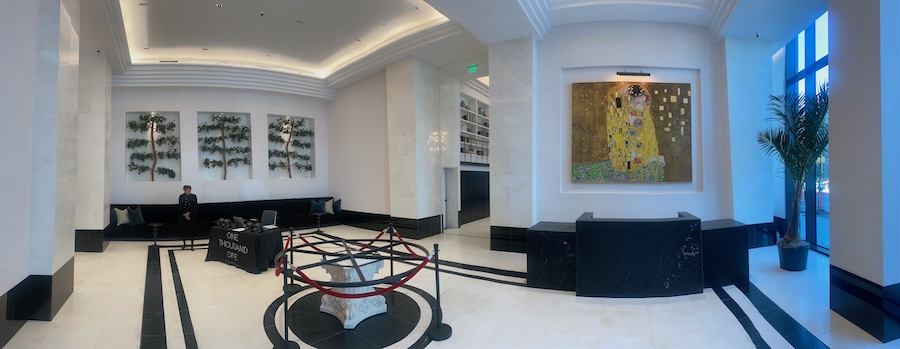
Panoramic view of the lobby*
As a result, tenants in Post Brothers apartments are getting older. Figures supplied by vice president for marketing Anthony Scotland show that the average age of Post tenants has risen over the last five years and now stands at 32 years old.
And the tenants moving into Post Brothers buildings are also earning more. “Individual incomes for our average renter have increased between 25 and 43 percent since the start of the pandemic,” says Scotland. That works out to individual renters’ incomes rising from an average $88,000 per year to $110,000 per year.
These trends put together mean that tenants in this area will likely remain tenants for longer. Thus the apartments in the building are sized to accommodate growing families. The apartments themselves have larger footprints, and there are more two- and three-bedroom units — 181 in all.
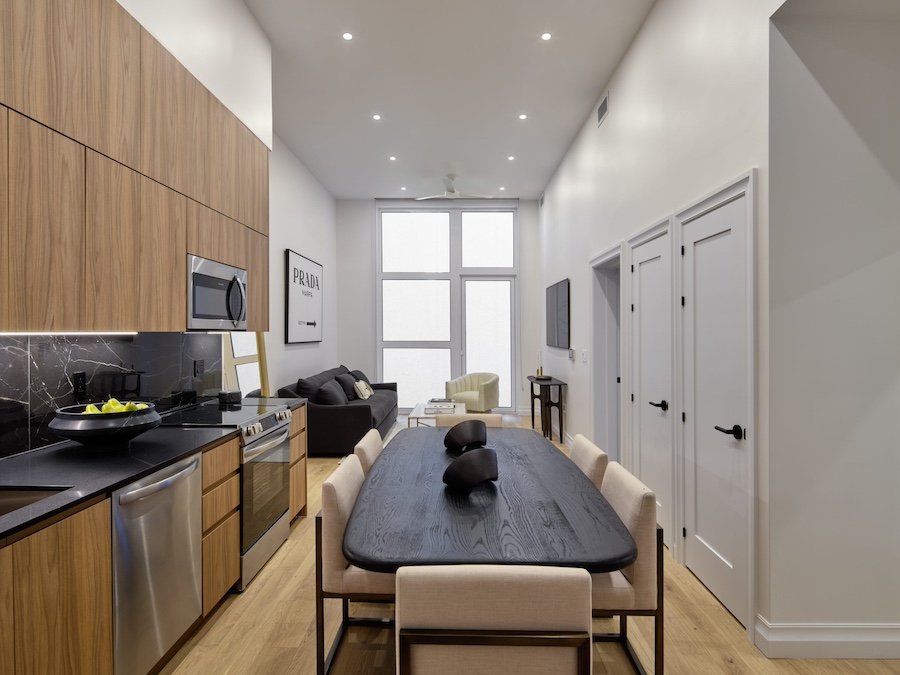
The model one-bedroom apartment features the “Fusion” kitchen and bathroom design package and a bedroom in black. Apartments come in three different packages of finishes and fixtures
Post Brothers also filled One Thousand One with style and amenities designed to keep those tenants satisfied for a good long while.
When the building is finished, those amenities will include two rooftop terraces, one for everyone and one just for the kids.
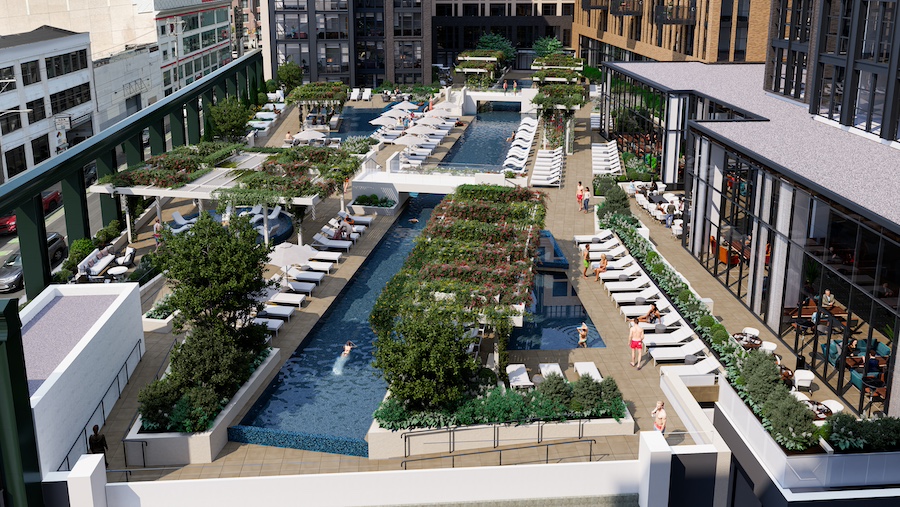
Rendering of the Canopy Pool Club
The one for everyone will feature a 169-foot-long pool that meanders around islands, under bridges and through hanging gardens.
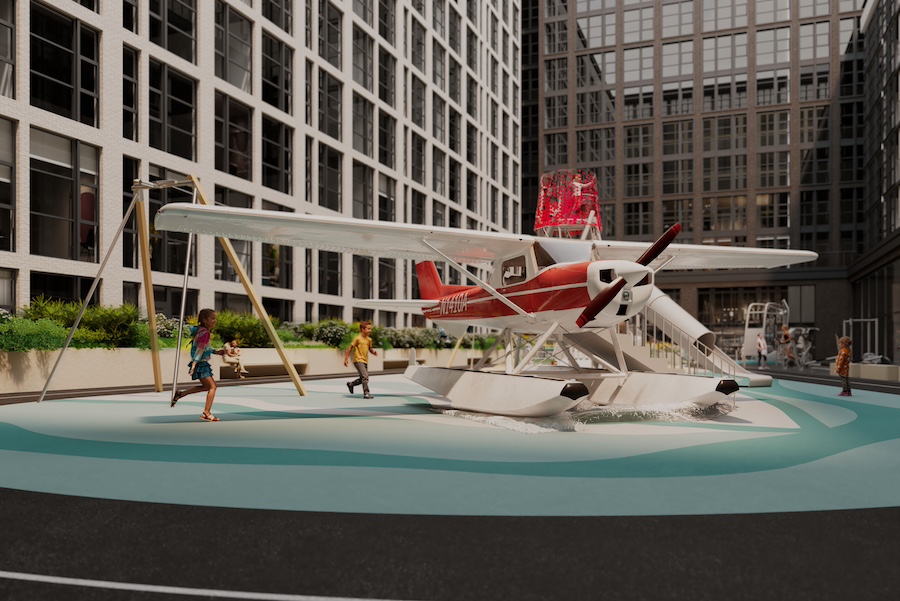
Rendering of the splash pad in the Adventure Garden, the children’s roof deck
The one for the kids will include a splash pad with a seaplane they can climb into. It will also include a rubberized track where they can learn to ride bikes safely. “There’s nowhere safe to teach your kid to ride a bike in the city,” says Pestronk. “So this track, it’s the only safe place to teach your kids — they’ll fall over but they won’t get hurt.”
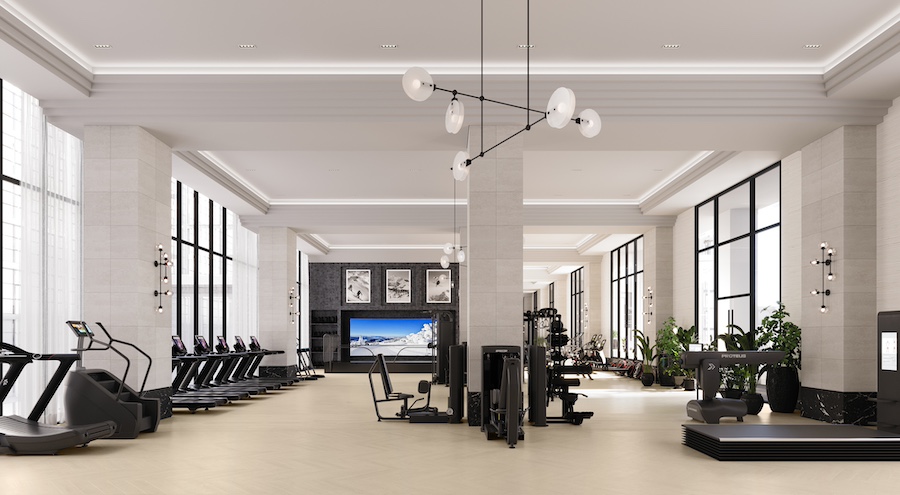
Rendering of the fitness center
The building will also have a 16,000-square-foot fitness center with recovery spas for men and women; work on that space was nearly complete when I toured the building. Other first-phase amenities include co-working facilities, a dog park and a lobby lounge.
Both the lounge and the building itself offer modern style with a nod to the Jazz Age. The ridged tray ceilings and lighting all give the lobby lounge an Art Deco accent.
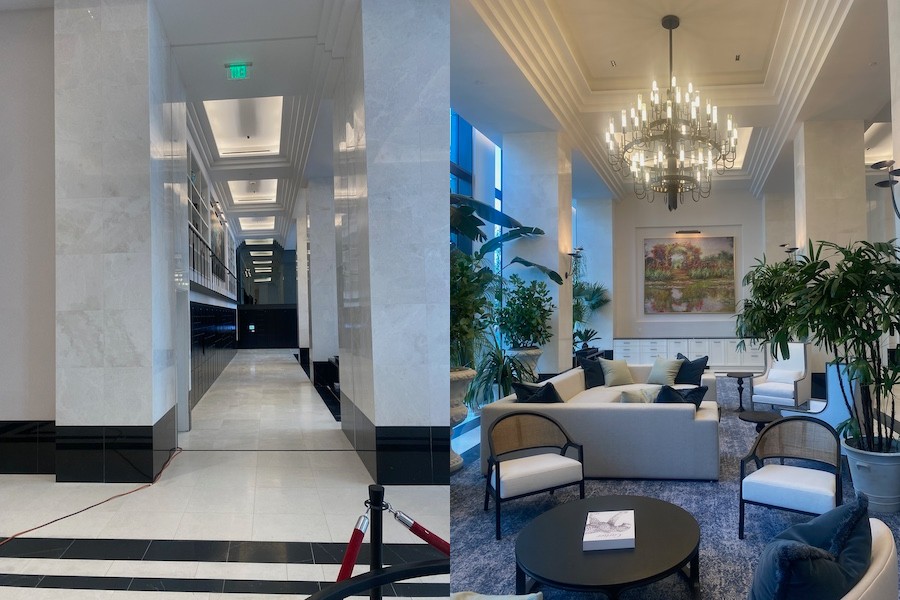
Entrance to (left) and interior of (right) lobby lounge*
And the exterior features the first use I’ve seen in decades of a building material common in the 1920s and 1930s: Terra cotta frames the entrance and the street-floor windows. Pestronk explained why terra cotta so rarely appears on buildings: “One, there are very few suppliers; and two, there are very few contractors who know how to work with it. It’s very unforgiving. It has to be made in a factory to precise measurements; you can’t cut it to fit on site” as one can with brick, wood or metal.
Another amenity that will serve both the tenants and the larger community is a Giant supermarket that will fill 40,000 of the project’s planned 66,000 square feet of retail space. Both tenants and shoppers who drive will arrive via an interior drive located where Juniper Street would run, a recommendation the neighbors made to Blatstein during this project’s gestation period. Separate ramps and entrances will accommodate residents and their visitors and supermarket patrons.
Leaving aside the supermarket, One Thousand One will have 77,000 square feet of amenity space and 630 apartments. The project’s second phase will include an additional 63,000 square feet of amenities. The completed project will contain 1,486 apartments, making it both the largest multi-unit residential development in the city and a small city unto itself.
This first phase cost the joint venture $400 million, or half of the development’s projected total cost of $800 million. Pestronk explained that one reason Post Brothers can deliver luxury apartments for relatively reasonable rents is because they can sniff out value: “Our superpower is building things that look like they cost $600 a square foot for $300 a square foot.”
One Thousand One by the Numbers
Address: 1001 South Broad Street, Philadelphia, PA 19147
Number of units: 630 studio, one-, two-, and three-bedroom apartments: 239 studios ranging in size from 410 to 600 square feet; 210 one-bedroom units ranging from 640 to 1,140 square feet; 126 two-bedroom units ranging from 970 to 1,580 square feet, and 55 three-bedroom units ranging in size from 1,250 to 3,160 square feet.
Number of parking spaces; 278, including 50 electric-vehicle charging stations, in this phase; Post says this is the most EV charging stations in a Philadelphia apartment building
Number of bike parking spaces: 210 in this phase
Pet policy: Pets welcome, up to two per unit, with a $1,000 deposit plus $50 per month rent per pet. No breed or size restrictions.
Rent ranges: Studios, $1,895 to $2,395 per month; one-bedrooms, $2,595 to $4,995 per month; two-bedrooms, $4,195 to $5,995 per month; three-bedrooms, $5,395 to $15,995 per month.
More information: One Thousand One website; leasing office on site; live1001@postrents.com; 267-792-0563
